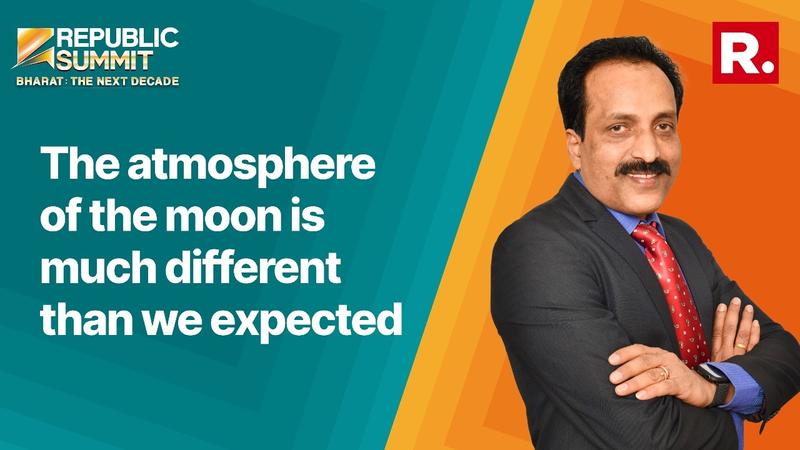Published 16:43 IST, March 7th 2024
Moon is Different Than We Expected: ISRO Chief's Big Revelation About Chandrayaan 3 Mission
ISRO's S Somanath revealed unexpected findings about lunar ‘dust’ that, if true, have the potential to change the approach to human spaceflight to the Moon.

New Delhi: The Chief of the Indian Space Research Organisation (ISRO), S. Somanath, speaking at the Republic Summit on Thursday, said ISRO scientists found that the Moon was a bit different than what the space agency had anticipated earlier. "The atmosphere of the moon is much different than we expected,” he said. This was indeed the ISRO Chief’s big revelation, although Somanath says that it needs to be corroborated further.
During the Chandrayaan 3 Mission’s landing, scientists found that there were hardly any dust particles that they (ISRO scientists) had anticipated around the equator.
This led to a surprising question that came to ISRO’s mind: why weren't any dust particles, as already seen during the Apollo landing, and why was the scene so different? Hence, following his statement, the Indian space agency’s chairman went on to add, "We (ISRO) found no dust there (on the Moon), contrary to our belief.” Probably this is also the reason why we couldn't see the dust particles when the rover roved around the lunar south pole. Although Somanath added that more will be revealed following a peer review and after being put in a journal, as it needs more corroboration to be conclusive and that requires time, “most surprising things are to be kept a surprise," the ISRO Chief said.
Why ISRO’s ‘No Dust’ Revelation is Important
As per NASA claims, astronauts who had walked the moon’s surface had experienced symptoms like sneezing and congestion, called ‘lunar hay fever’. This happened because of the dusty surface of the moon. Now, experts are studying whether this dust could harm future space travellers. The lunar dust is sharp and can stay in the air for a long time, making it easy to breathe in. On Earth, miners who inhale similar dust suffer from lung problems.
The moon's lack of atmosphere and constant exposure to sunlight make its dust even more dangerous, NASA reports added. However, scientists also see potential benefits. The dust can be used to make bricks for shelters and extract oxygen for astronauts. Researchers are testing simulated moon dust to understand its effects better, and ISRO’s revelation might just help expand humanity’s knowledge bank further. The Indian Space Agency finding might just help make future missions to the Moon safer for astronauts.
As per Surmises, if there were negligible lunar dust, future moon missions would face fewer health risks for astronauts. Without the abrasive and potentially toxic dust, there would be no concerns about respiratory problems or equipment damage (a mission could be designed to be more cost-effective). This would streamline mission operations and reduce the need for extensive dust reduction measures.
Overall, a lunar environment with minimal dust would increase the safety and efficiency of human exploration on the Moon.
Objective Behind Lunar South Pole Landing
Further speaking about the Chandrayaan 3 mission, the ISRO chief added that the target of ISRO was to land closer to the south pole. The reason for that is because the Moon’s structure is well preserved, and the area has the highest probability of finding water, if any, as the craters on the Moon might store it in the form of ice.
Human Spaceflight, Vision for India’s Tech Leap, and Future Aspirations
Further, during the Republic Summit held on March 7, Somanath also spoke about his vision of India becoming a technologically advanced nation in the next decade. He then highlighted the important role of the space sector in various fields such as agriculture, digital technology, and artificial intelligence, adding that advancements in the space sector will contribute to India's overall development.
Following this, Somanath commended ISRO's ability to execute missions on a shoestring budget, which experts consider India's capability unprecedented even on a global scale. He also mentioned the Gaganyaan mission, differentiating it from regular rocket launches as it involves human spaceflight. On the Gaganyaan Mission, the ISRO Chief said that the possible human spaceflight, an ambition that India has had for a while now, could be launched by 2025. The mission aims to send the four astronauts designated, who recently received their ‘Astro Wings’ from Prime Minister Modi during a ceremony at ISRO's Kerala facility, to space and bring them back to India safely.
Somanath, while concluding his address, said there are “smart minds everywhere in the country; they are not getting the right opportunities; communication is important but needs to expand to villages as well," he added. Then the ISRO chief spoke about how Chandrayaan 3 was able to access the remote parts of India as well and how people from rural areas came to know of the feat. Children in villages were inspired by our work on Chandrayaan, ISRO Chief S. Somanath said, while also adding that ISRO’s achievements have turned more children into dreamers.
Updated 19:18 IST, March 8th 2024




